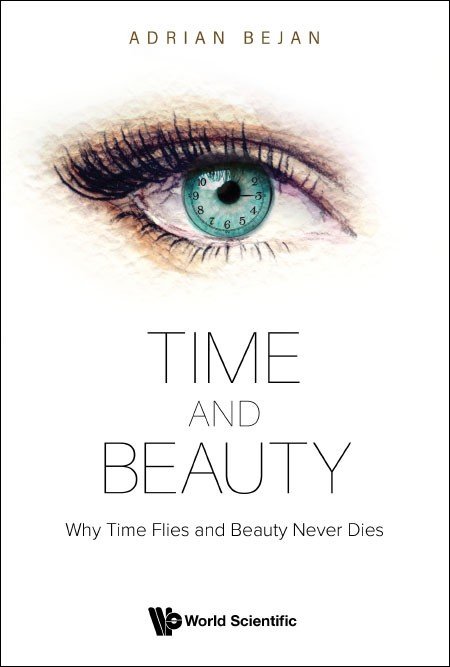Time and beauty are two of our most visceral perceptions. Yet, their nature is seldom questioned. In this ground-breaking new work, Adrian Bejan — a true 'original' among physicists — explains, in a scholarly yet colorful style, the scientific basis for the perception of time and beauty.
Organized into three main ideas, the book begins first with the perception of time. The author expounds on why we feel that time flies faster as we get older. Perceived time, also called "mind time," is different from clock time. In this context, time is another word for "perceived change". Next, readers will discover that beauty is appealing because beautifully-shaped images are scanned faster by two eyes. To observe our immediate surroundings and to understand them faster is highly advantageous to survival; hence, there is an underlying evolutionary advantage to our discernment for ideal ratios, shapes, and beauty at large. Finally, time and beauty are jointly understood to explain why the global pandemic had decelerated our mind time. This understanding arms us with techniques to slow down our mind time (which accelerates with age), and to create the conditions for living longer and more creatively.
Scientists may have contemplated aspects of time and beauty separately. In contrast, the author submits an original and rewarding approach to understanding them together. In the process, key questions to our cognition are answered. Why does the mind "try" to make sense of a new mental image? Why is there a natural tendency to organize a new input and mentally position it among past perceptions? Through physics, the book offers a general answer: to empower the individual with speed and clarity of thought, understanding, decision-making and movement. The same answer holds for the other disparate perceptions illustrated in this book, from time and beauty to ideas, message, shape, perspective, art, science, illusions, and dreams.
Related Link(s)
Sample Chapter(s)
1: Overview
Contents:
- Acknowledgement
- Overview
- Speeding Time
- Beauty
- Contrast
- Shape
- Idea
- Perspective
- Art and Science
- Slowing Time
- Design Science
- Index
Readership: General audience; laypersons, scientists and professionals who are interested in the connections between perceived time and beauty, derived from a scientific approach.
"A book for everyone, artists, engineers, politicians, economists … in short, a book that must be read if you want to do what you do better … If the next generation is to succeed in creating a sustainable society, they will need to know Adrian Bejan and his 'Constructal Law'."
Jarl Jensen
Author of The Big Solution: Deactivating the Ticking Time Bomb of Today's Economy
"Time and Beauty is Bejan at his interdisciplinary best, applying the 'Constructal Law' — the deep patterns of flow that pervade nature and human life — to the metaphysical domain. In explaining how a life of change can slow down the seemingly rapid passage of 'human time', he provides invaluable wisdom in how to lead a healthier and more fulfilling life."
Dr Parag Khanna
Author of Connectography and MOVE
"There is in the time of old age, always, that fleeting moment when the child who has never left us opens his eyes to the person he has become and exclaims: 'Already!' Reading Time and Beauty, the attentive reader can only say to himself: 'I understood', and finally find his human adventure beautiful. When science and consciousness unite, so the eternal soul is built in the Golden Ratio, where beauty never dies. Thank you Professor Adrian BEJAN."
Patrick Kalason
Author of Le Grimoire des Rois, théorie constructale du changement and
Théodicée Constructale des Cultes Abrahamiques
Adrian Bejan was awarded the 2018 Benjamin Franklin Medal for "his pioneering interdisciplinary contributions in thermodynamics and Constructal theory, which predicts natural design and its evolution in engineering, scientific, and social systems."
He received the 2019 Humboldt prize for "his pioneering contributions to modern Thermodynamics and Constructal Law — a law of physics that predicts natural design and its evolution in biology, geophysics, climate change, technology, social organization, evolutionary design and development, wealth and sustainability."
He earned his degrees from the Massachusetts Institute of Technology: BS (1971, Honors Course), MS (1972, Honors Course) and PhD (1975). He was Fellow of the Miller Institute for Basic Research in Science, University of California Berkeley (1976–1978). Since 1989 he is the J A Jones Distinguished Professor at Duke University.
Adrian Bejan's research is in Physics, thermodynamics, theoretical biology, design and evolution everywhere in nature, animate, inanimate, social and technological. His impact on science is due to highly original ideas of theory, modeling, analysis, and design that today bear his name: entropy generation minimization, scale analysis, intersection of asymptotes, temperature-heat diagram, heatlines, constructal law, animal design, the science of form (design), and evolution 'as physics'.
He is the author of more than 30 books and 690 peer-reviewed journal articles. His work is highly influential, as supported by a h-index of 102 and 81,000 total citations. According to the 2019 world rankings of 'citations impact', he is the 477th among world scientists, and 9th in Engineering: https://journals.plos.org/plosbiology/article?id=10.1371/journal.pbio.3000384
His impact on science is due to highly original ideas of theory, modeling, analysis, and design that today bear his name: entropy generation minimization, scale analysis, intersection of asymptotes, temperature-heat diagram, heatlines, constructal law, animal design, the science of form (design), and evolution 'as physics'.
Adrian Bejan's books are used worldwide (multiple editions and translations), for example: Advanced Engineering Thermodynamics (Wiley 2016) and Convection Heat Transfer (Wiley 2013), Design in Nature (Doubleday 2012), The Physics of Life (St. Martin's Press 2016) and Freedom and Evolution (Springer Nature 2020).
He was awarded 18 honorary doctorates from universities in 11 countries, for example, Swiss Federal Institute of Technology (ETH Zurich), University of Rome I "La Sapienza", National Institute of Applied Sciences (INSA) Lyon, and University of Pretoria. He is a member of the Academy of Europe and the national academies of Mexico, Turkey, Romania, and Moldova.
He received the major international awards for thermal sciences, for example, Honorary Member of the American Society of Mechanical Engineers (ASME 2011), Ralph Coats Roe Medal (2017 ASME), Max Jakob Memorial Award (1999 ASME & AIChE), Heat Transfer Memorial Award (1994 ASME), Worcester Reed Warner Medal (1996 ASME), Luikov Medal (2006 Int. Center Heat Mass Transfer), and Donald Q Kern Award (2008 AIChE).



